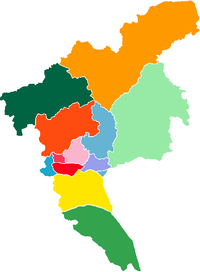Guangdong Museum
| 广东省博物馆 | |
 Guangdong Museum main building (2017) | |
| Established | 1959 |
|---|---|
| Location | Guangzhou, China |
| Coordinates | 23°07′34″N 113°16′18″E / 23.12613°N 113.27154°ECoordinates: 23°07′34″N 113°16′18″E / 23.12613°N 113.27154°E |
| Visitors | 1,557,000 (2016)[1] |
.jpg)
The Guangdong Museum (Chinese: 广东省博物馆) is a general museum in Guangzhou, Guangdong, China.
History
Old building
The Guangdong Provincial Museum was located on 215 Wenming Rd., Guangzhou, Guangdong Province of China, on what was the original site of Sun Yat-sen University. It was a provincial general museum, founded in 1959 and with a land area of 43,000 square meters. It comprised three major parts: the museum, the relic of first national congress of Kuomintang and Lu Xun Memorial House. Other affiliated buildings include Red Tower (红楼) and the observatory of Sun Yat-sen University.
There are two separate buildings. The building which housed the original National Sun Yat-sen University became the Lu Xun Memorial Hall and contains an exhibition of objects related to Lu Xun and some other intellectuals who influenced Chinese modernization and indirectly prepared the way for the communist revolution.
The newer building to the right was initially built in 1957-1959 and greatly enlarged in 1992. It contains several distinct exhibitions and has notices in English. In the historical exhibition of "Chaozhou wood carving" , on display are screens and other objects elaborately carved in wood as well as an explanation of the history and different techniques used in the art.
The next section on the ground floor was an exhibition of modern ceramic figures done in traditional Shiwan (Foshan) style. Each window was dedicated to a different artist with a brief biography and some examples of their work.
Upstairs there was a section dedicated to the history of the city of Guangzhou from prehistoric times to the modern days. Guangzhou was always a center of trade with foreign nations and many of the objects from the semi-colonial years come from England (postcards, pictures and other documents).
Another section housed an exhibition of old Chinese pottery and china wares while yet another section contains posters in traditional Chinese calligraphy.
Not long after the opening of the new Guangdong Museum in May 2010, the old Guangdong Province Museum closed its doors permanently.
Relocation
In 2003, the Guangdong government made a future master plan for Zhujiang New Town as a new center of Guangzhou city. In this plan, Zhujiang New Town Plaza is the cultural center of the city with a series of pavilions and public facilities, such as Gaungdong Museum, Guagnzhou Opera House, Guangdong Library and an activity center for teenagers. In 2004, the old Guangdong Museum was relocated to Zhujiang New Town. The new museum occupies 41,000 square meters above ground and 15,000 square meters underground. The building holds an interior area of 66,980 square meters with viewing areas for patrons comprising 21,000 square meters, including a large open grass slope around the building to the public.
Architecture
The design of the museum, comprising a kind of multi-layer, delicate, transparent spatial configuration, was inspired by the traditional Cantonese ivory puzzle ball, which is characterized by a delicate stack of carved ivory, similar to an onion.Thus, the Spatial arrangement of the museum is designed to follow the ivory-layered composition of traditional Cantonese crafted artwork with multiple transparent concentric layers expanding from the atrium towards the periphery spaces. The main circulation space is a spiral staircase that goes from the first floor to the top floor, landing at different exhibition areas on each floor. Separated by transparent glass and iron curtain, the corridors on each floor lead visitors from outside into the four-story atrium to gain a overall view of the interior space.The ivory puzzle ball represents the great technique of Cantonese vernacular craftsmanship. Therefore, as a cultural symbol, the ivory sculpture gives the Canton museum both a meaningful spatial concept and cultural resonance.
Exhibition Spaces
The Museum's main exhibition space consists of a historical room, a natural exhibition space, and a Vernacular art exhibition area, which together house the museum's permanent collections. Temporary exhibitions are updated frequently to the public, offering citizens a chance to look at foreign art works and exotic treasures. The atrium and corridors are areas for people to take rest, while the office and administration spaces are at the top of the museum.
See also
References
- ↑ "TEA-AECOM 2016 Theme Index and Museum Index: The Global Attractions Attendance Report" (PDF). Themed Entertainment Association. pp. 68–73. Retrieved 23 March 2018.
External links
| Wikimedia Commons has media related to Guangdong Museum. |

